inReach: Experiencing Challenges and Joy on the Pacific Crest Trail
UPDATE: When we first interviewed Australian Rachel Coffey about her attempt to hike the Pacific Crest Trail (PCT) in 2017, Rachel shared that she was unable to complete the thru-hike when portions of the trail were closed due to fires. We reached out to Rachel to learn about her return to the U.S. this year and her experience completing the hike. Read more.
The Pacific Crest Trail (PCT) spans 2,650 miles from California’s border with Mexico to Boundary Monument 78 on the U.S./Canada border in Washington state. The Pacific Crest Trail Association noted that in 2017, nearly 4,000 long-distance permits were issued to thru-hikers and horseback riders from all 50 states and 46 countries and territories.
One of those thru-hikers came from Australia. Rachel Coffey, the daughter of 2 schoolteachers who took her camping and bushwalking on holidays, grew up in a small coastal town south of Melbourne. In 2016, Coffey was “searching for direction, challenge and inspiration,” which led her to fly to the U.S. on a whim and hike the John Muir Trail (JMT). The beauty and happiness she experienced on that adventure led her to commit to hiking the PCT the following year.
Coffey spent 5 intense months hiking the PCT in a year that presented extraordinary challenges due to record-breaking snowpack in the mountains and raging wildfires. Coffey shared with Garmin the details of her experience and advice for hikers considering the PCT.
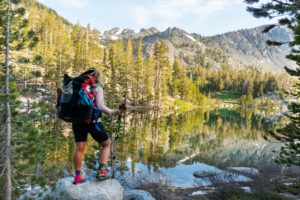
What planning is essential for the PCT? What were the gear choices you made? And what proved to be essential?
I spent so many sleepless nights researching gear and trying to find the best utility-to-weight ratio for me. I absolutely loved my sleep system. I was freezing on the JMT, so I learned from that and invested in a cozy sleeping bag, a really comfortable and warm inflatable mattress and a small inflatable pillow. There wasn’t a single night that I didn’t crawl into bed and feel thankful to be warm, dry and comfortable.
It was a constant battle to keep my pack as light as possible, so with every item I chose to add, I had to sacrifice something else. For the first 2 months, I went without my stove so that I could carry an extra piece of camera gear. I managed to convince myself that drinking cold instant coffee dissolved in an ice-cream container was an acceptable way to live. Let me assure you, it is not! I’ll never hike stove-less again!
Was safety ever a concern for you, being solo to begin?
It was a pretty intense year on the PCT, and 2017 came to be known as the “Year of Fire and Ice,” with record-breaking snow in the Sierra and wildfires ravaging many parts of the trail in late summer. Because of this, I ended up doing a flip-flop hike, where I was trying to puzzle together different sections of the trail to avoid fire. This meant I was completely alone more often than I anticipated.
I spent the last 2 months hiking alone and, to be completely honest, was pretty terrified for a lot of it. There were a few weeks where the only other footprints I saw on the trail were bear prints, and I didn’t see another human for days on end. The season was changing, and days were getting shorter, which meant I often had to walk at night to make my miles for the day. One night, my headlamp caught the eyes of what I’m certain was a mountain lion watching me in the darkness. I yelled and banged my trekking poles, but it didn’t budge and just kept on watching me. I had to just keep walking, singing loudly and trying to sound loud and large. I stopped periodically to turn 360 degrees to see if it was following me. I never did see it again, but I felt pretty alone and vulnerable with no other humans for hundreds of miles.
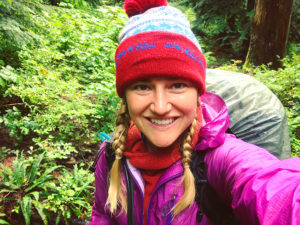
What was the beginning of the hike like? Were you well prepared for what you encountered?
The PCT begins with 700 miles of desert. I was fit and strong, but I don’t think anything could prepare me for walking in that sun for 12 hours a day. It took me a few days of mild dehydration and heat rash to embrace the concept of night-hiking — crowding with other hikers under sparse shade for the hottest part of the day, then hiking until midnight (or occasionally all night) to avoid the worst of the heat.
How did you use your inReach satellite communication device during the hike?
Initially, I decided to carry an inReach® to appease my parents. I thought my mum would like to know that I had a means of emergency communication. While having MapShare and the tracking capabilities of the inReach device was comforting, it ended up being the ability to text back and forth with people at home that was an emotional savior for me. In the weeks of feeling very lonely and isolated, knowing that I could send a tearful text to my family and get a supportive reply really helped me feel less alone.
and the tracking capabilities of the inReach device was comforting, it ended up being the ability to text back and forth with people at home that was an emotional savior for me. In the weeks of feeling very lonely and isolated, knowing that I could send a tearful text to my family and get a supportive reply really helped me feel less alone.
I set up an emergency plan with my dad before I left. It was my nightmare to look up to see a helicopter needlessly descending to rescue me, just because my battery had died or because I’d left the inReach on a log somewhere. I wanted to make sure I had backup plans to avoid that. Dad knew when I expected to be in a town and tracked me religiously [via MapShare]from home. It was actually very sweet. In the mornings, Mum said Dad would wake her up with a report of how many miles I’d walked and where I’d camped for the night. Once I’d finished hiking, Dad was devastated when I told him I was cutting him off and that he no longer had permission to track my every move.
Hiking the PCT (or any popular thru-hike) appears to be a mixture of a sometimes solitary and sometimes social adventure. People acquire trail names, join up with others and are sometimes solitary for long stretches. What was your experience like?
I was quickly dubbed “Pony Express” because of my knack for finding, carrying and returning missing belongings to other hikers. I also carry a very well-stocked first aid kit, so my friend Otter gave me the trail name because “I deliver.”
Within the first 2 miles of the Mexican border, I already had some awesome friends — some of whom I walked with for hundreds of miles. At one point, my group of walking buddies ballooned to 12, then contracted down eventually to just me.
I didn’t expect to enjoy the social aspect of thru-hiking as much as I did. I often find it tiring to be in a group environment, but it was different on the PCT. After walking all day, no one has the energy to pretend to be anything other than their true selves. When you find a group of people who love you for exactly who you are (filthy, sweaty, smelly and exhausted), it’s an incredible feeling.
I felt that I learned a lot about myself from the time I did spend in solitude, and while there was sometimes beauty and power in tackling the trail alone, I would prefer to share it with others. 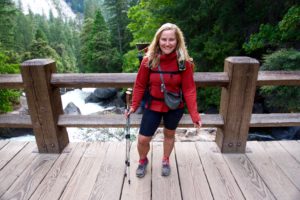
As the peak season to begin hiking the PCT is approaching, what advice would you give to someone planning to hike the PCT?
In the weeks leading up to my start date, I was plagued by self-doubt and fear. You can and probably will find almost anything to worry about before a thru-hike. And for good reason — the stakes are high. You’ve put aside 5 or 6 months of your life and probably put a few big things in motion: quit your job, given up your place to live, got rid of your car, spent lots of money on gear and made a very public commitment to attempt something extraordinary. There is pressure. But with risk comes reward, and it is oh so worth it.
The saying “the trail provides” is so appropriate. Never in my life have I encountered as much kindness and generosity as when hiking the PCT. Hikers shared medication and cups of hot tea when I was in need, and trail angels opened their homes and their hearts to me, making me feel like family. Facing and overcoming all of those fears, discovering the good in people and the strength inside yourself is what makes hiking a long trail so transformative.
We saw a number of SOS incidents from inReach users on the PCT this year. Some were due to the heavy snow pack in the north, and others were from fires, dehydration or even robberies. You mentioned the specific challenge of having to avoid areas due to fires. Could you tell us more about the challenges or if you encountered emergencies?
2017 was pretty gnarly. The Sierra experienced incredibly heavy snowfall, which was still thick on the ground when “the bubble” of hikers began to hit the mountains in May and June. My friends and I entered the Sierra around “peak melt,” when overnight temperatures were staying pretty high, snow was melting rapidly and the rivers were raging. I’ve never crossed a dangerous river, and I’ve barely spent any time in the snow before hiking the PCT, so it was a pretty steep learning curve. I hiked this section with an awesome group of people who taught me how to glissade, minimize post-holing and most importantly, self-arrest with my ice axe (a skill that saved my life). We got through the Sierra safely, but tragically, 2 other solo hikers drowned trying to cross the swollen rivers — 1 on the same day we crossed. Hearing of people losing their lives on the trail was devastating. The cohort of hikers is very interconnected. We share information about water sources, passes and rivers, and there is a genuine sense that we are all in it together.
Later in the hike, plumes of smoke from surrounding wildfires became a common sight. Often, I’d wake up with ash on my sleeping bag. My dad was keeping a keen eye on wind direction and wildfire activity back home in Australia, often sending updates to my inReach about trail closures or reassuring me that the smoke I could see was more distant than it appeared. I never had an immediate emergency but often felt that the risks were pretty real. Because of fire closures in 2017, I still have about 500 miles to hike in Oregon and Northern California.
When you first reached out to us, you shared that you were planning a documentary film about your hike. Is that still in the works?
As a filmmaker and storyteller, documenting the adventure felt really important. Feeling creative on the trail also brought me a lot of joy. I filmed the ups and downs of my personal journey and with the footage will create a feature-length documentary aimed at adventure film festivals. The film uses diary-style video entries as well as interviews with other women on the trail to share the physical and emotional experience of thru-hiking.
I want the film to inspire women and girls to strive toward epic outdoor adventures. Many women are thriving in the outdoor adventure space, but we don’t often see them on screens. I’m sharing my story to encourage people to question what truly makes them happy and have the confidence to go and find it.
The film is called “The Mountains Are Calling,” and you can see a couple of short videos on my website: themountainsarecalling.org.
2018 Update
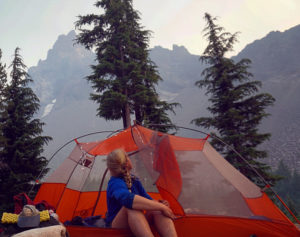
Where did you go on your recent hike?
I had around 600 miles of the PCT still to complete this summer. Large sections of the trail in Northern California, Oregon and Washington were closed last hiking season due to wildfires. I hiked over 2,000 miles last year, but I came to a point where completing the whole trail would have involved a lot of road walking and hitchhiking to get around fire closures. I had to really consider my goals and values and decided that it was more important to me to hike those miles on trails in wilderness than it was to complete the hike in 1 year.
Why was it important to complete the PCT? Did you finish the portions you wanted to complete?
Leaving the PCT unfinished was absolutely not an option for me. It’s hard to explain the pull of that trail and the lure of a long-distance hike, but anyone who has set themselves a big goal will understand. Life kept rolling along back in Australia, but I always felt like part of me was still hovering near the PCT, waiting to finish it.
Despite landing an awesome TV job (the best job I’ve ever had), once the winter snow had melted and the trail crews had worked miracles to get the PCT back open, I was on a plane back to America to keep hiking. I spent the summer/autumn walking all of the miles that I missed last year, so now I have walked every mile between Mexico and Canada — even if it wasn’t in a straight line! There was still at least a month of usable hiking weather that I was determined not to waste. I teamed back up with my hiking partner from last year, and we re-hiked a 400-mile section of the PCT from Donner Pass (near Lake Tahoe) south through the Sierra to Mt. Whitney. Those miles are through some of the most spectacular wilderness in the world, and I could happily re-hike them every year for the rest of my life.
Was your return trip different in some way than your first attempt to hike the PCT?
The return trip was different, because I was in a different place emotionally. Plus, I felt more confident and sure of myself as a hiker. I think a lot of people experience impostor syndrome, whether it’s in a work context, a social situation or a thru-hike. They feel like they don’t necessarily belong there and are waiting for people to discover their ineptitudes. I don’t think I’m the only one who felt like that hiking the PCT at times. There’s always someone to compare yourself to — someone faster, with a lighter pack and more experience.
But this second season hiking the PCT, I felt secure and confident. I think the time away from the trail allowed me to return to it emotionally stronger. Getting back on trail felt like coming home. My tent, the forest, the mountain peaks, the people, the solitude, the constant walking — I feel like everyone and everything welcomed me back.
I assume conditions were different this time. In your view, how were they different?
There were wildfires on trail again this year, and some hikers had to skip/flip/flop to avoid them. Again, there was a lot of smoke, which compromised views and air quality. All things considered though, 2018 was a much better year to hike the PCT. Closures were generally small and not too hard to get around. The Sierra snowpack was below average, which made the mountains passable from an earlier stage in the year as well.
Although I would have had a better chance of completing the PCT in 1 season if I’d begun this year instead, I still don’t regret tackling the PCT in 2017. Even though it was sometimes a logistical nightmare, and the snow and rivers in the Sierra were at times terrifying, I’ve never seen anything as beautiful as those mountains in heavy snow. It was also the biggest challenge of my life, and I’m so proud to have taken it on.
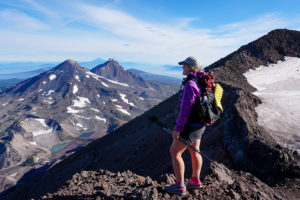
What’s your next adventure?
My next short-term adventure will be a 7- to 10-day solo hike somewhere much more local before I go back to work. Australian summer is about to start, and Tasmania is looking pretty appealing! Luckily, my boss was very understanding and supportive of my PCT obsession and wants to take me back even though I disappeared into the wilderness for months on end.
Long term, there are other long-distance hikes that call to me: the 1,000-kilometer Bibbulmun Track in Western Australia, New Zealand’s 3,000-kilometer Te Araroa and the 5,000-kilometer Continental Divide Trail. I think thru-hiking will be a lifelong love.
Are there more plans for your documentary?
I filmed a few more interviews on my hike this year and am really looking forward to putting the documentary together. I met some incredible people who I think are really inspiring and who share their thoughts on body image, anxiety and mental health and the feeling of “belonging” on trail. I have a lot of footage, so it will take some time to edit, but I’ll post updates on Instagram® when it’s ready to watch.
Rachel Coffey is a television producer/director and a hiking guide in Grampians National Park. You can follow her on Instagram® @hiker_rach.
To access the Iridium satellite network for live tracking and messaging, including SOS capabilities, an active satellite subscription is required.
NOTICE: Some jurisdictions regulate or prohibit the use of satellite communications devices. It is the responsibility of the user to know and follow all applicable laws in the jurisdictions where the device is intended to be used.
The post inReach: Experiencing Challenges and Joy on the Pacific Crest Trail appeared first on Garmin Blog.
Sample Block Quote
Praesent vestibulum congue tellus at fringilla. Curabitur vitae semper sem, eu convallis est. Cras felis nunc commodo loremous convallis vitae interdum non nisl. Maecenas ac est sit amet augue pharetra convallis nec danos.
Sample Paragraph Text
Praesent vestibulum congue tellus at fringilla. Curabitur vitae semper sem, eu convallis est. Cras felis nunc commodo eu convallis vitae interdum non nisl. Maecenas ac est sit amet augue pharetra convallis nec danos dui.
Cras suscipit quam et turpis eleifend vitae malesuada magna congue. Damus id ullamcorper neque. Sed vitae mi a mi pretium aliquet ac sed elitos. Pellentesque nulla eros accumsan quis justo at tincidunt lobortis denimes loremous. Suspendisse vestibulum lectus in lectus volutpat, ut dapibus purus pulvinar. Vestibulum sit amet auctor ipsum.

